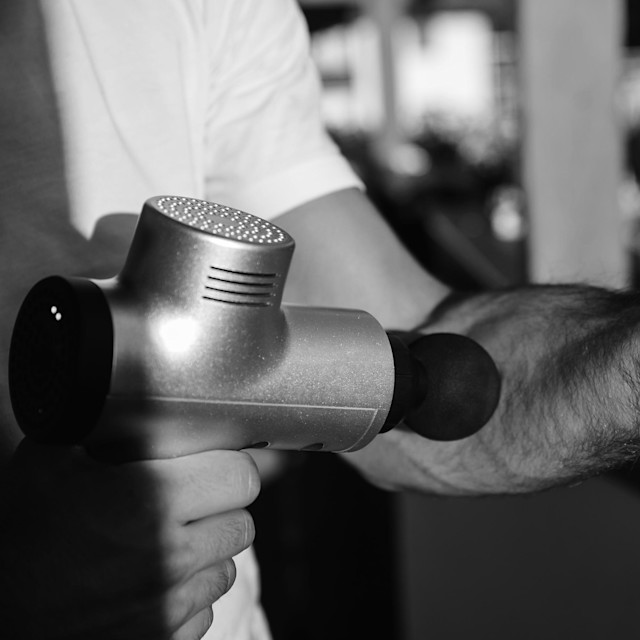It has pre- and post-workout benefits.
While you may think of self-care as a soothing Epsom salt bath or post-workout sauna visit, vibrating massage guns like the Hypervolt (available online at The Shop) take a more aggressive approach.
With a shape reminiscent of a power drill, these devices provide a quick alternative to deep tissue massages or foam rolling. Though the experience may be ticklish, uncomfortable, or even painful as you work through tight areas, it can provide workout and recovery benefits.
Here, the intel:
How percussive therapy works
“Percussive therapy [also known as percussion massage or tapotement] is rapid tapping used to relax tight tissue and promote circulation,” explains Cassie Holzmann, LMT, New York City–based field educator for Equinox Body Lab.
Unlike traditional manual bodywork, handheld massage tools emit repetitive pulses, which provide more consistency of pressure and frequency of percussions per minute, says Holzmann.
The pre- and post-workout benefits
The best way to think of a percussion therapy device is as an efficient warm-up tool, allowing you to get in deeper and quicker than you could with a foam roller, Holzmann says. Used before a workout, the machine primes your muscles for movement to help prevent injury and improve your range of motion, she adds.
Experts recommend using the device after your workout too, to help relieve soreness and stiffness (though you should still remember to make stretching a part of your routine). “Incorporating the Hypervolt helps get through the bulk of the taut tissue that’s contracted after a workout to break up any knotty adhesions. It will also promote circulation, which significantly helps with recovery," Holzmann explains.
Through EQX Body Lab, available in select Equinox locations, you can book a Hypervolt session before or after your workout, or as an add-on to any massage. Your therapist can tailor these sessions to the particular muscles you’ll be working during group fitness or personal training.
Using a percussion massage device on your own
It’s ideal to have a trained professional (like a physical therapist or licensed massage therapist) assist you with hard-to-reach areas like your back. But one of the reasons these devices have become so popular is the ease of using them on yourself, whether in the locker room or at home.
Before you get started, learn these guidelines from Holzmann:
1. Start on a slower speed setting and work up to a faster one, adding more pressure before you add more speed.
2. Prior to a workout, go quicker up and down each muscle group with the device, targeting tight areas. Afterwards, stick to a slower speed setting and move more slowly.
3. Stay in areas with bulky tissue and avoid bone (like the tailbone), being extra careful around the spine and neck. The device will start to jump and feel uncomfortable.
4. Vary the head attachments depending on your goal. Holzmann uses the flat head attachment on a broader area of dense tissue like the hamstrings, and uses a narrow head attachment on specific trigger points.
